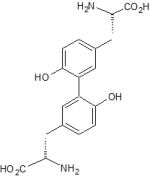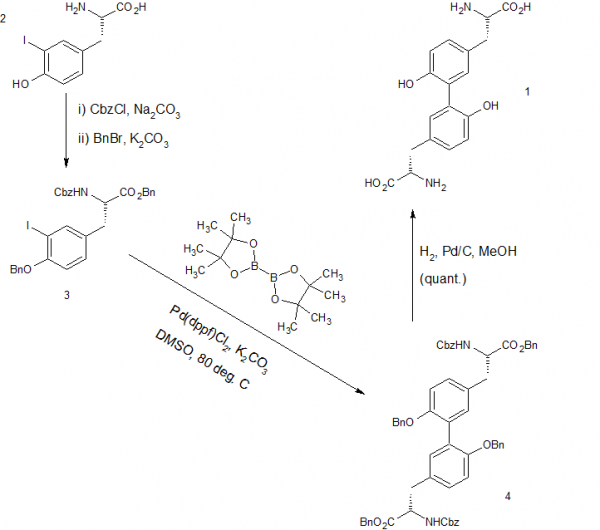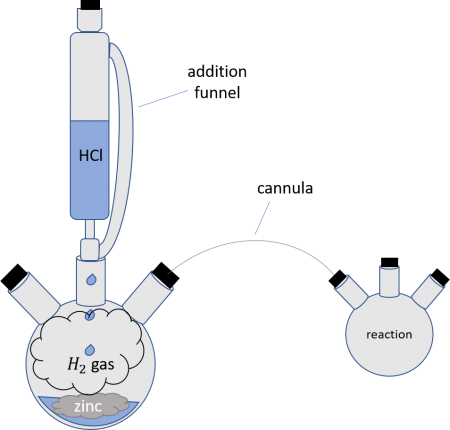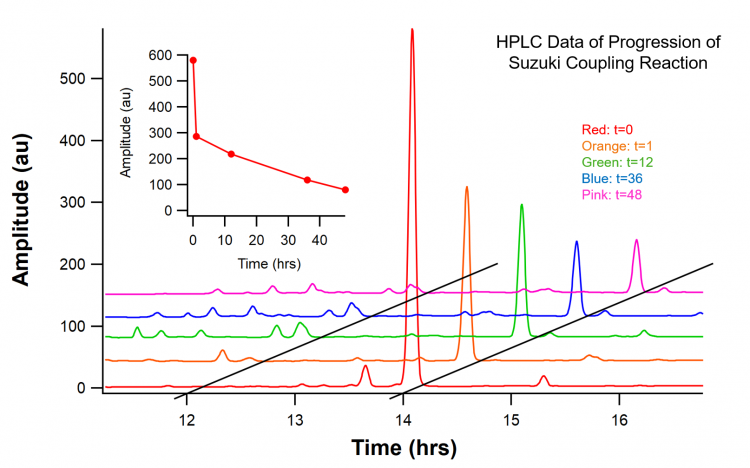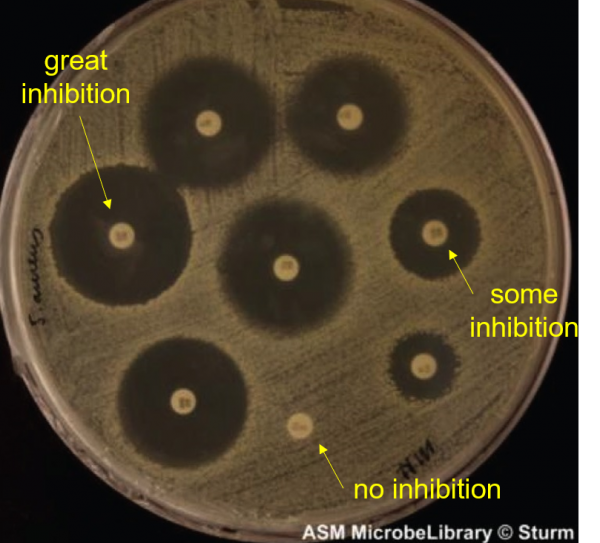Difference between revisions of "Investigating the Organic Synthesis of Dityrosine"
| Line 11: | Line 11: | ||
| − | [[File:Dityrosine_molecule.png|frameless|center| | + | [[File:Dityrosine_molecule.png|frameless|center|150px|]] |
Revision as of 15:46, 3 May 2021
You have reached the page dedicated to research investigating an efficient organic synthesis of the dityrosine molecule. This research is carried out by Monmouth College undergraduate Katelyn Richter under the supervision of Dr. Bradley Sturgeon.
Introduction
New interest in peptides and proteins containing cross-linked dityrosine residues is increasing due to fascinating biological properties they have. Dityrosine is the dimerized form of the amino acid L-tyrosine. Some examples of said biological properties include increased stabilization of structures, conformational restriction of cyclic peptides, and variation in the electronic properties seen in enzyme active sites (Skaff et al., 2005). The possibilities of application in biological systems make tyrosine dimers a molecule of great intrigue. Dityrosine cross-linking also has a plethora of applications in the realm of biomaterials that mimic cellular environments with great potential for developing ground-breaking techniques in regenerative medicine and tissue engineering (Partlow et al., 2016). Dityrosine research also provides great insight into the progression of Alzheimer’s disease, which can be defined as the aggregation of insoluble amyloid plaques in the neuropil composed of highly stable, self-assembled Amyloid-beta42 fibrils, the neurotoxic dimerization of which is a direct result of dityrosine cross-linking (Al-Hilaly et al., 2013).
Furthermore, protein tyrosine and tryptophan have been identified as targets of photo-oxidation in milk and in other food products that contain proteins with high concentrations of these residues. The flexible structure of β-casein in milk favors radical–radical termination of tyrosyl radicals to produce dityrosine (Dalsgaard et al., 2011). Research on chitin also explores the possibilities of tyrosine. Chitin is one of the most abundant renewable nitrogenous materials accessible to humans, obtainable through the shells of crustaceans. However, the direct conversion of crustacean shell waste-derived chitin into nitrogen-containing chemicals is challenging using standard catalytic processes. To address this challenge, researchers are developing an integrated biorefinery process to upgrade shell waste-derived chitin into two aromatic NCCs, L-DOPA and tyrosine (Ma et al., 2020).
Both lignin and tyrosine also have the ability to dimerize via oxidative coupling to form lignan and dityrosine, respectively (Dimmel, 2010). Like dityrosine, lignan dimers have been shown to demonstrate a wide array of biological applications. Historical use of lignan has been traced back to a variety of folk and traditional medicines, and more current research has found lignan to have therapeutic effects on tumors in the digestive, reproductive, and endocrine systems (Dimmel, 2010). Unfortunately, lignin has proved complicated to isolate from natural products without alterations to convert to consumer-grade products (Dimmel, 2010).
Project Goals
The goals of this project are as follows:
1. Optimize a synthesis pathway for dityrosine.
In order to study dityrosine, it is necessary to synthesize it rather than buy it. Dityrosine is only available to buy as a standard, and even the smallest quantities of it are quite expensive. For the Sturgeon group's intents and purposes, a larger amount of this compound is needed.
2. Apply dityrosine synthesis pathway to synthesis of dityrosine derivatives.
Once the organic synthesis of dityrosine has been optimized, it can be applied to the synthesis of dityrosine derivatives. Some of these analogs could be made by simply brominating or chlorinating an aromatic ring, the addition of a nitro group, etc.
3. Test dityrosine and derivatives for biological properties via Kirby-Bauer Disk Diffusion Assay.
Once the molecules of interest have been synthesized and purified, they will be tested for various biological properties, such as antifungal and antibacterial properties, in the hopes that some of the analogs will show some significant or interesting biological activity.
Methods
Organic Synthesis Pathway
Below is the proposed synthesis for dityrosine from Skaff et al. (2005):
The starting molecule is 3-iodo-L-tyrosine. This compound is reacted first with benzyl chloroformate and sodium carbonate followed by benzyl bromide and potassium carbonate. This step adds three protecting groups to the molecule. After the protecting groups have been added, this protected intermediate undergoes a Suzuki coupling reaction, which creates a bond between the two aromatic rings. This is accomplished using the Suzuki reagent, bis-pinacolato diboron. Once the coupling is complete, the molecule is deprotected using palladium on charcoal and hydrogen, yielding the final molecule of dityrosine. Chromatography is performed between each step to purify intermediates as well as the final product.
N-Cbz-4-O-Benzyl-3-iodo-L-Tyrosine Benzyl Ester 3
Potassium carbonate (2.60 mL, 48.8 mmol), 3-iodo-L-tyrosine (2) (2.03 g, 16.3 mmol), and deionized water (25 mL) were added to a round bottom flask submerged in an ice bath. A mixture of 50% benzyl chloroformate in toluene (1.71 g, 25.0 mmol) was gradually add to the reaction over a period of 30 minutes while the flask remained in the ice bath. A white precipitate fell out of solution as the 50% benzyl chloroformate solution was added. The reaction was removed from the ice bath and left to mix at room temperature for 24 hours. The reaction mixture was acidified to pH 4 using HCl, and aqueous extraction was performed using ethyl acetate (3 x 100 mL). The organic extracts were washed with saturated sodium chloride solution (2 x 100 mL). The organic extracts were dried with magnesium sulfate and concentrated under vacuo to yield Cbz-3-iodo-L-tyrosine as a white crystalline substance submerged in a yellow oil. Potassium carbonate (2.58 g, 49.2 mmol) and tetrabutylammonium iodide (18 mg) was added to Cbz-3-iodo-L-tyrosine in dry acetone (100 mL). Nitrogen was bubbled through the reaction for 15 minutes, and benzyl bromide (1.7 mL, 35.9 mmol) was added. The reaction was refluxed in the dark for 24 hours. Aqueous extraction was performed using dichloromethane (2 x 100 mL) and water (100 mL). The organic extract was concentrated under vacuo yielding Intermediate 3 as a pale yellow oil (9.01 g). The oil was chromatographed in reverse phase on a silica gel column eluting ethyl acetate/hexane (1:9 - 9:1 gradient). Fractions 31-44 were combined and concentrated under vacuo to yield a white crystalline solid (2.42 g, 25% yield).
Protected Dityrosine 4
Intermediate 3 (2.42 g, 0.00378 mol), potassium carbonate (0.200 g, 0.00151 mol), Pd(dppf)Cl2 (5 mg), and bis(pinacolato)diboron (50 mg) were added to DMSO (50 mL) in a round bottom flask. The reaction was maintained at 80 °C and stirred under nitrogen for 48 hours. Aqueous extraction was performed on the reaction mixture with ethyl acetate (100 mL x 2) and a saturated NaCl solution (100 mL x 2). The organic extracts were combined, dried with magnesium sulfate, and concentrated under vacuo to give Protected dityrosine 4 as a dark brown oil (2.42 g).
Dityrosine 1
To Protected Dityrosine 4 (0.30g, 0.30 mmol) was added methanol (12 mL) and 10% palladium on charcoal (0.03 g, 0.03 mmol) in a round bottom flask. The reaction was stirred under hydrogen at room temperature for 48 hours. H2 gas was generated using zinc and 3 M HCl. The resulting mixture was filtered through celite and washed with 1 M HCl (50 mL). Aqueous extraction was performed using ethyl acetate (150 mL x 2). The organic extracts were concentrated under vacuo to yield crude Dityrosine 1 (1.72 g) in the form of a pale yellow oil. The reaction was chromatographed on silica eluting H2O/CH3CN/TFA (95:5:0.05).
Reaction set up:
Results and Discussion
Figure 1: Thin Layer Chromatography (TLC) is typically the preferred method for mediating the progression of organic reactions. However, there is also opportunity to utilize High Performance Liquid Chromatography (HPLC) as well to observe the disappearance of reactants and the formation of products. HPLC was used to observe the Suzuki coupling reaction which forms the protected dityrosine intermediate. To prepare samples, an aliquot (three drops) of the reaction was added to a sample vial and brought to a volume of 1 mL with methanol with methanol. This was done five times as the reaction progressed at the initiation of the reaction, 1 hour, 12 hours, 36 hours, and 48 hours. As the reaction continued, the reactant peak (observed at 14 minutes) decreased. This can also be observed in this smaller red graph in the upper left corner. Various products also formed in small amounts (observed between 2 and 12 minutes). However, there does not appear to be one major product based on these spectra alone. This is because the protected dityrosine intermediate was insoluble in the reaction mixture. As a result, it was left at the bottom of the flask rather than being drawn up with sample aliquots taken for analysis. After aqueous extraction and concentration under vacuo of the reaction, the major product was a viscous brown oil.
Current Work and Future Plans
The synthesis has been completed up to the Suzuki coupling reaction. The protected dityrosine intermediate is the most recent intermediate that has been synthesized. Future work on this project includes the purification of the protected dityrosine intermediate via column chromatography, as well as the deprotection of this intermediate to obtain the final product of dityrosine. The final dityrosine product will also be purified via column chromatography.
Following the synthesis of dityrosine, the molecule will be tested for antibacterial properties against a nonvirulent strain of E. coli via Kirby-Bauer Disk Diffusion assay. Analogs of dityrosine will also be synthesized and tested for antibacterial properties to investigate whether derivatized forms of dityrosine have possible medicinal applications.
Kirby-Bauer Disk Diffusion Assay
The Kirby Bauer Disk Diffusion Assay is a common, reliable, and simple technique for examining antimicrobial properties of potential drugs (Ho et al., 1998). It is a sensitive, convenient and inexpensive method of screening (Manganyi et al., 2018). Kirby Bauer Disk Diffusion assays will be carried out using a nonvirulent strain of E. coli on glucose minimal media plates. The plates are completely coated with the bacteria and disks containing compounds of interest will be placed onto the plate. After the bacteria’s incubation period, the zones of inhibition surrounding each disk containing the compound of interest will be recorded. The larger the zone of inhibition, the more effective the compound is as an antibiotic. This test can also be performed with fungi.
References
1. Synthesis of the side chain cross-linked tyrosine oligomers dityrosine, trityrosine, and pulcherosine
- Ojia Skaff, Katrina A. Jolliffe, and Craig A. Hutton, The Journal of Organic Chemistry 2005 70 (18), 7353-7363, DOI: 10.1021/jo051076m
2. Dityrosine cross-linking in designing biomaterials
- Benjamin P. Partlow, Matthew B. Applegate, Fiorenzo G. Omenetto, and David L. Kaplan, ACS Biomaterials Science & Engineering 2016 2 (12), 2 108-2121, DOI: 10.1021/acsbiomaterials.6b00454
3. A central role for dityrosine crosslinking of Amyloid-β in Alzheimer’s disease
- Youssra K. Al-Hilaly et al., PubMed 2013, DOI: 10.1186/2051-5960-1-83
4. Reliability of the Kirby-Bauer Disc Diffusion Method for Detecting Methicillin-Resistant Strains of Staphylococcus aureus, W. Lawrence Drew,
- A. L. Barry, Richard O'Toole, John C. Sherris, Applied Microbiology Aug 1972, 24 (2) 240-247
5. P L Ho, K H Chow, K Y Yuen, W S Ng, P Y Chau, Comparison of a novel, inhibitor-potentiated disc-diffusion test with other methods for the
- detection of extended-spectrum beta-lactamases in Escherichia coli and Klebsiella pneumoniae., Journal of Antimicrobial Chemotherapy, Volume 42,
- Issue 1, Jul 1998, Pages 49–54, https://doi.org/10.1093/jac/42.1.49
6. M.C. Manganyi, T. Regnier, A. Kumar, C.C. Bezuidenhout, C.N. Ateba,
- Biodiversity and antibacterial screening of endophytic fungi isolated from Pelargonium sidoides, South African Journal of Botany, 2018, 192-199, ISSN
- 0254-6299, https://doi.org/10.1016/j.sajb.2018.03.016.
Document History
- - Project started by K. Richter in Fall 2020

